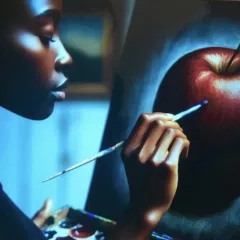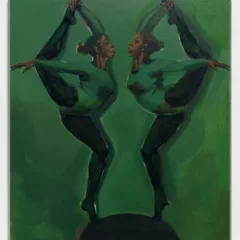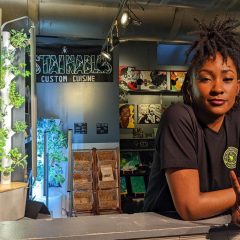Post by Andrea Kirsh
Our trusty correspondent Andrea Kirsh reports from Art Basel/Miami Beach, in four installments. Here’s the first.–r&l
Miami, December 6

Jiffy hybrid tji wara and Cignal hybrid tji wara, by Willie Cole, at Alexander and Bonin
I’m a Miami native, and worked in the art world here during the 1980s, but my annual visits aren’t enough to keep up with the changes in the built landscape or with Miami’s art scene. The only time I’ve seen this many cranes was in Berlin in 2002, when it was still reacting to re-unification.
Each successive year Art Basel/Miami Beach is surrounded by more peripheral fairs; this year there were 10, some on Miami Beach and others across the bay in Miami. I’ve come to think these are more interesting (and certainly easier to take) than the main event. With 200 galleries in the Miami Beach Convention Center, AB/MB is overwhelming, so most of my comments will be about the Scope, NADA and Bridge fairs. AB/MB’s opening for VIPs (the big buyers) and press was from 11 to 6, and by 4 pm when I arrived, the crowd was already milling and much work had already been sold. The public opening (available to anyone willing to pay, or on someone’s comp list) was from 6 to 10.
Constructing New Berlin
After being turned out of the fair at 10 pm, I walked three blocks to the Bass Museum of Art, to see Constructing New Berlin, an interesting exhibition of photo_derived art by 18 international artists who had worked in the city. Some was photography proper (Thomas Demand, Frank Thiel and others), and the first impression was of the size–a sort of gigantism–and quality of the color printing. There were a number of paintings done after photographs as well as video, and a light installation by Olafur Eliason that was hard to appreciate fully with the bustle of the party. Several of the artists (Eliason, Janet Cardiff and George Bures Miller) had shown more substantial installations in Philadelphia in recent seasons. The tone was roughly divided between the poetic and the gritty. Erwin Kneihsl’s portraits of a youthful sub-culture were attached to the wall with day-glo tape; don’t ask how they will be removed.
I found Johannes Kahrs’ paintings remarkably moving, especially one focusing on the hands of a woman: her prominent veins belied her age, while the red fingernails suggested a concern for fashion and lamented youth. His virtuosic paint handling of the head of a young blond woman managed to keep it from resembling a Technicolor version of a Gerhard Richter. The exhibition was in the museum’s new wing, designed by Arata Isozaki (2002), a long-awaited expansion of the 1930s building.
Art history at Art Basel/Miami Beach

Fuckface (2005), by Kendall Geers, at Friedman, Art Basel Miami Beach
One point that struck me repeatedly with work I saw in Miami was that artists today seem more interested in art history than ever – that’s my interpretation of the frequency with which they are citing earlier art. Some of the citations are ironic, others clearly done in homage. A few examples culled from the AB/MB catalogue: Willie Cole re-creates the forms of Bambara Sculpture out of bicycle frames (photo); Michael Elmgreen and Ingar Dragset arrange green, white and red canvases, pierced and slashed a la Fontana, to mimic the Italian flag; Kendell Geers paints a skull, titled Fuckface, presumably in response to Gabriel Orozco; Alain Jacquet’s Camouflage Mondrian, Broadway inserts a girl with flowers, in the style of a children’s book, into Broadway Boogie Woogie; and William Daniel’s Napolean Crossing the Saint Bernard Pass is a painted grisaille version of David’s painting, looking as though it was constructed of torn paper. No anxiety of influence here; rather, gratitude for past imagery and its ready-made associations.
–Andrea Kirsh, an art historian living in Philadelphia, was curator at the Lowe Art Museum, University of Miami and Assistant Director of Miami-Dade Art In Public Places in the 1980s. She is author of Seeing Through Paintings; Physical Examination in Art Historical Studies, written with Rustin S. Levenson , a conservator with studios in Miami and New York City. The book is available in paperback and can be found at the MMA bookstore or the usual web resources.










